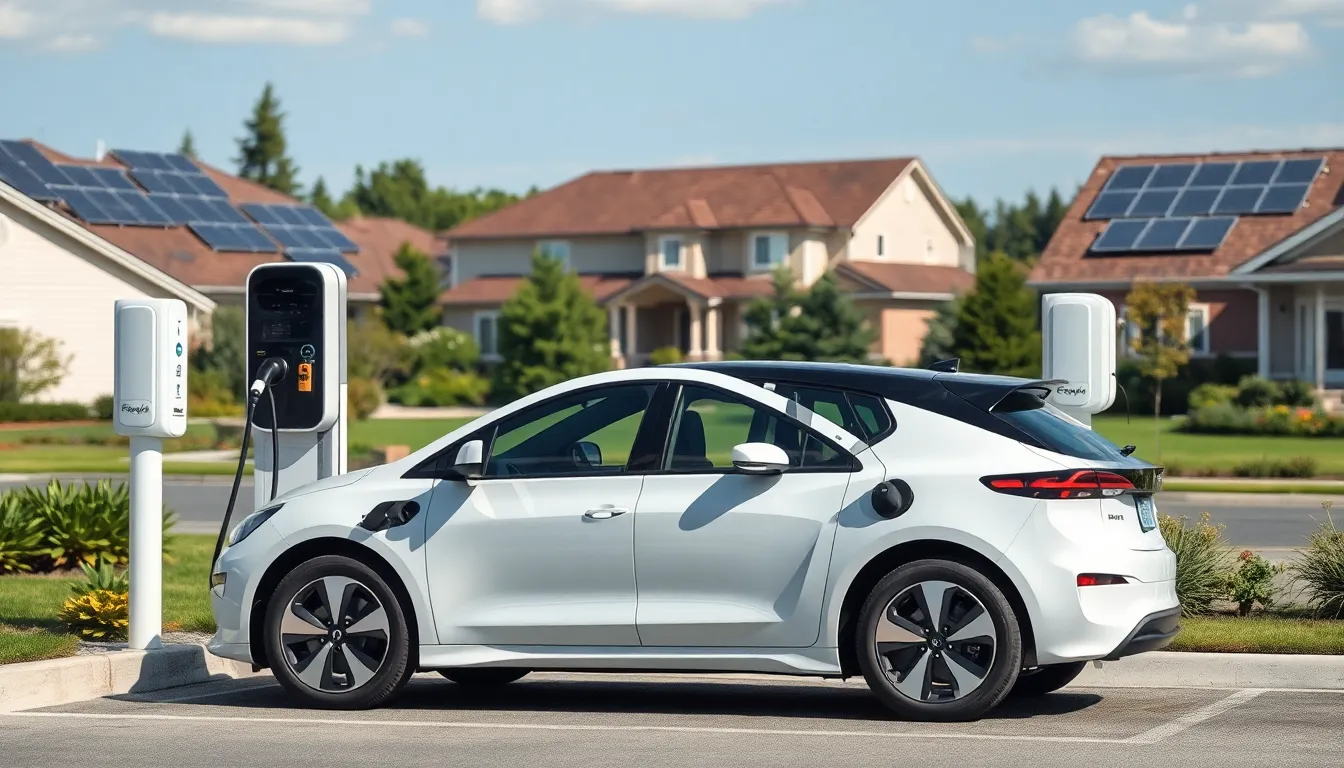As the world shifts towards sustainable energy solutions, Vehicle-to-Grid (V2G) technology emerges as a game-changer in the energy landscape. This innovative system allows electric vehicles to not only draw power from the grid but also return excess energy when needed. With the rise of renewable energy sources, V2G presents a unique opportunity to balance supply and demand while maximizing the use of clean energy.
Imagine a future where your car serves as a mobile energy storage unit, helping to stabilize the grid and even earning you money in the process. V2G technology not only enhances energy efficiency but also plays a crucial role in reducing greenhouse gas emissions. As more people adopt electric vehicles, understanding V2G’s potential becomes essential for both consumers and energy providers alike.
Table of Contents
ToggleOverview of Vehicle-to-Grid Technology
Vehicle-to-Grid (V2G) technology enables electric vehicles to exchange energy with the electrical grid. V2G systems allow vehicles to draw power and return surplus energy, creating a two-way communication avenue between electric vehicles and energy infrastructure. This technology leverages the battery capacity of electric vehicles, turning them into mobile energy storage units.
V2G benefits both consumers and energy providers. Consumers gain financial incentives through energy credits by selling stored energy back to the grid during peak demand periods. Energy providers benefit from enhanced grid stability and better management of energy loads, particularly with variable renewable energy sources.
According to a study by the National Renewable Energy Laboratory, V2G can potentially add up to $2.4 billion in value annually to the U.S. economy by 2030. This figure highlights the technology’s role in supporting the transition to a more sustainable energy landscape.
V2G technology addresses critical issues such as energy demand fluctuations and the integration of renewable energy. The technology supports grid resilience by providing a buffer during high demand, helping to balance energy supply and demand. As electric vehicle adoption increases, V2G systems offer a practical solution for enhancing energy efficiency and reducing greenhouse gas emissions.
Key Components of Vehicle-to-Grid Systems

Vehicle-to-Grid (V2G) systems rely on several key components to function effectively. These elements ensure proper communication, energy transfer, and overall efficiency between electric vehicles and the power grid.
Electric Vehicles
Electric vehicles (EVs) serve as the backbone of V2G systems. Each EV contains high-capacity batteries that store energy, allowing vehicles to not only consume electricity from the grid but also return excess energy. These batteries include advanced management systems that monitor charge levels and health, ensuring they can safely support V2G operations. The integration of smart technology enables two-way communication between the vehicle and the grid, facilitating real-time energy transactions and optimizing charging patterns based on demand. Major manufacturers are developing EV models specifically designed for V2G capabilities, which enhances the technology’s adoption.
Charging Infrastructure
Charging infrastructure plays a vital role in V2G systems by enabling efficient energy flow. Bidirectional chargers are essential components that allow EVs to both receive and supply energy. These chargers connect to the grid and communicate with energy management systems for optimal performance. Many locations, such as public charging stations and residential setups, are beginning to feature bidirectional capabilities, facilitating a seamless energy exchange. As the charging infrastructure expands, the overall V2G network becomes more robust, supporting greater adoption of renewable energy sources and enhancing grid reliability. By integrating advanced charging stations, the energy management process becomes streamlined, boosting the efficiency of both EV usage and grid stability.
Benefits of Vehicle-to-Grid Technology
Vehicle-to-Grid (V2G) technology offers multiple advantages, particularly in enhancing energy management and promoting environmental sustainability. The integration of electric vehicles into the energy grid presents significant opportunities for efficiency and ecological benefits.
Energy Efficiency
Sustained energy efficiency emerges as a key advantage of V2G technology. Electric vehicles optimize energy usage by storing excess power generated from renewable sources, which can be fed back to the grid when demand peaks. This process reduces the need for additional fossil-fuel-based power generation. A study by the National Renewable Energy Laboratory indicates that V2G systems could reduce peak energy demand by 10-20%, leading to improved overall system efficiency. Furthermore, with advanced management systems, EVs can participate in demand response programs, allowing for further optimization of energy flows and reducing the generation of energy wastage.
Environmental Impact
Significant environmental benefits accompany the adoption of V2G technology. By capitalizing on renewable energy sources, V2G reduces greenhouse gas emissions, contributing to cleaner air and a healthier environment. EVs functioning as mobile energy storage units enhance grid resilience and stability, allowing for higher integration of intermittent renewable energies like solar and wind. As per recent reports, deploying V2G systems could lead to a potential reduction of up to 80 million metric tons of CO2 emissions annually by 2030. This evolution in energy management not only supports sustainability efforts but also fosters a cleaner future.
Challenges and Limitations
Vehicle-to-Grid (V2G) technology faces several challenges and limitations that impact its widespread deployment. Understanding these obstacles is crucial for advancing this innovative energy solution.
Technical Barriers
Technical barriers hinder the full implementation of V2G systems. Compatibility between diverse electric vehicle models and charging infrastructure presents a significant challenge. V2G requires bidirectional chargers capable of facilitating energy exchange, yet many current EV charging stations only support one-way charging. Additionally, limited battery life and capacity in some EVs restrict their ability to participate in V2G operations. Communication protocols between vehicles and the grid also require standardization to ensure seamless transactions and data exchange. Lastly, the need for advanced energy management systems adds complexity to the integration and maintenance of V2G technology.
Regulatory Issues
Regulatory issues pose substantial hurdles for V2G technology. Many regions lack clear regulatory frameworks governing energy transactions between electric vehicles and the grid. Uncertainties around grid access, incentives, and compensation mechanisms can deter investment in the necessary infrastructure. Moreover, existing utility regulations might not take into account the unique aspects of V2G, creating legal and operational ambiguities. As stakeholders work toward effective solutions, collaboration among policymakers, utility companies, and technology developers is vital to create an enabling environment for V2G’s growth and effectiveness.
Future Trends in Vehicle-to-Grid Technology
V2G technology is set to evolve rapidly, aligning with advancements in renewable energy and smart grid systems. Increased adoption of electric vehicles drives demand for improved V2G applications. Enhancements in battery technology lead to longer-lasting, more efficient energy storage solutions. As manufacturers develop high-capacity batteries, vehicles can provide more energy back to the grid, supporting greater two-way energy flows.
Emerging innovations in charging infrastructure support V2G development. Deployment of bidirectional chargers allows seamless energy exchange, making V2G options more accessible to consumers and energy providers. As cities invest in smart charging networks, real-time data sharing between EVs and the grid optimizes energy management. These networks adjust energy transfers based on real-time demand, improving grid reliability.
Policy frameworks play a crucial role in shaping the future of V2G technology. Governments are increasingly implementing regulations that facilitate the integration of V2G systems into existing grid structures. These frameworks help establish clear compensation models for energy transactions, fostering investment in necessary infrastructure. Collaboration between stakeholders, including electric utilities and technology developers, is vital for overcoming regulatory challenges and harmonizing V2G operations.
Consumer awareness and acceptance of V2G technology are projected to rise. As the importance of sustainable practices gains traction, consumers recognize the potential financial benefits of participating in V2G systems. Educational campaigns can demystify V2G technology, encouraging more individuals to engage and invest in electric vehicles capable of contributing to the grid.
Research indicates that V2G technology is expected to expand significantly by 2030. Analysts predict an increase in V2G-capable EVs on the road, with projections estimating over 20 million vehicles contributing to energy systems in the United States alone. These estimates underscore the potential for V2G technology to become a mainstream component of future energy solutions.
Investments in advanced communication technologies enhance the functionality of V2G systems. The integration of the Internet of Things (IoT) into V2G networks allows for more sophisticated monitoring and management of energy flows. IoT-enabled systems promote efficiency and reliability, enabling better data-driven decision-making for consumers and grid operators alike.
The intersection of V2G technology and smart cities represents a significant trend in urban development. Cities that prioritize sustainability and energy resilience can leverage V2G systems to create more stable energy ecosystems. Engaging communities in energy management can lead to reduced electricity costs and improved environmental outcomes.
Emerging market opportunities will further influence V2G technology’s future. Expansion into developing regions offers unique challenges and prospects for V2G adoption. Strategies tailored to local energy needs can drive growth in these markets, adjusting for infrastructural and technological variances.
The convergence of these trends signals a robust future for Vehicle-to-Grid technology, positioning it as a cornerstone of sustainable energy solutions and a catalyst for economic growth.
Vehicle-to-Grid technology stands at the forefront of the energy transition. Its ability to transform electric vehicles into dynamic energy resources offers immense potential for both consumers and energy providers. By optimizing energy use and enhancing grid resilience, V2G paves the way for a sustainable future.
As adoption rates rise and infrastructure develops, V2G will likely play a pivotal role in managing energy demands and reducing reliance on fossil fuels. The collaboration among stakeholders will be essential to overcome existing challenges and unlock the full benefits of this innovative technology. With continued advancements on the horizon, the future of V2G looks promising, driving both economic growth and environmental sustainability.
